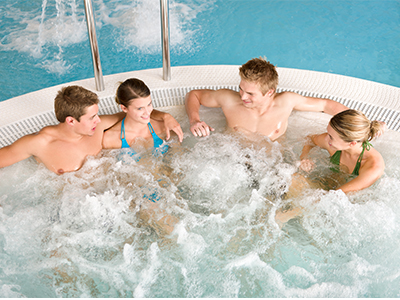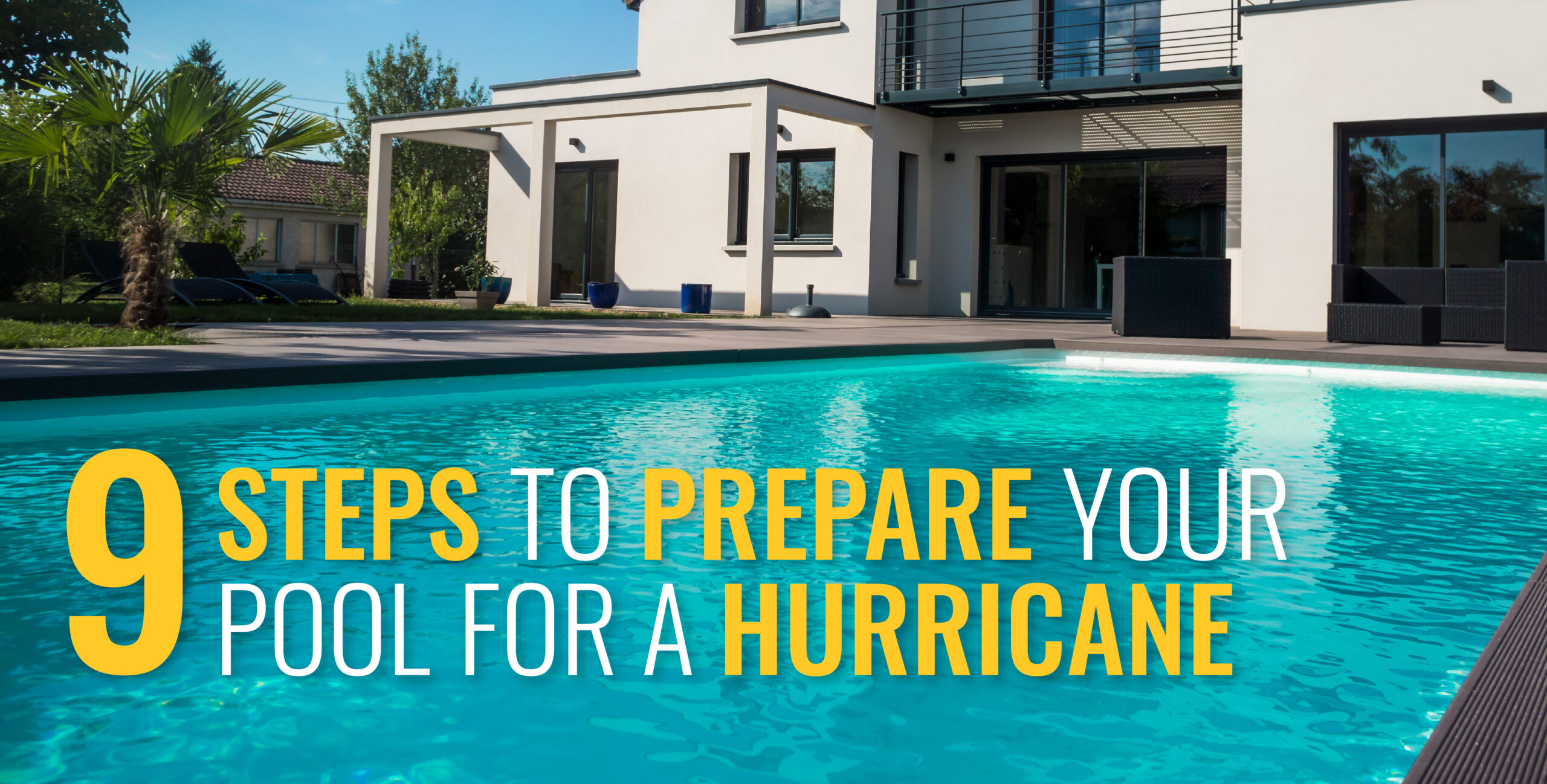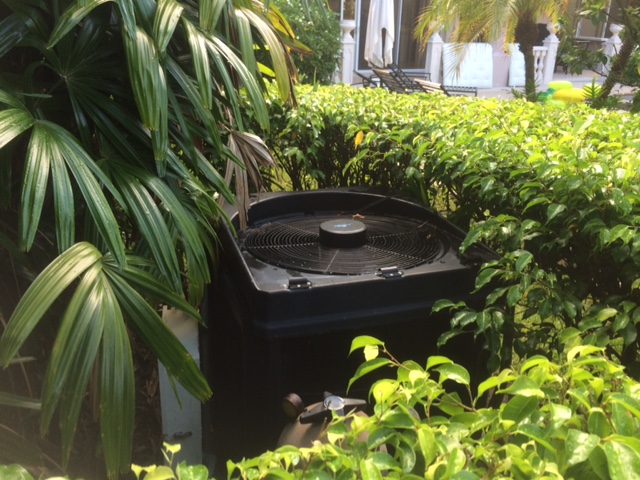As hurricane season approaches, it's crucial to ensure the safety of your property, including your…

How Quickly Can a Heat Pump Heat My Swimming Pool or Spa?
A common question we at AquaCal® often receive by customers is: “How much time does a heat pump require to heat my swimming pool/spa?” This is a great question, but not one that is easily answered. In this article, we discuss several factors that affect the heating time of your swimming pool or spa.
The required heating time of your swimming pool or spa depends on factors such as air temperature, heat pump size, swimming pool or spa size, current water temperature, desired water temperature, and use of a solar blanket. We look at each of these factors in detail below.
-
Air Temperature:
As we explain in our article entitled how-does-an-air-source-swimming-pool-heat-pump-work, air-source heat pumps depend on air temperature because they use heat from the air to warm your swimming pool or spa. Heat pumps operate most efficiently in temperatures exceeding 50°F (10°C). In temperatures below an average of 50°F (10°C), heat pumps cannot efficiently capture heat from the air and therefore require more time to warm your swimming pool or spa.
-
Heat Pump Size:
Swimming pool and spa heaters are sized according to their British Thermal Units (BTU) per hour. One BTU raises one pound of water by 1°F (0.6°C). One gallon of water is equal to 8.34 pounds of water, so 8.34 BTUs raises one gallon of water by 1°F (0.6°C). Consumers often purchase underpowered heat pumps in order to save money, but underpowered units have higher operating costs and require more time to heat your swimming pool. To properly size your heat pump, click here.
-
Swimming Pool or Spa Size:
Other factors held constant, larger swimming pools and spas require longer heating times.
-
Current and Desired Water Temperatures:
The greater the difference between your current and desired water temperatures, the longer you will need to run your heat pump.
-
Use of a Solar Blanket:
In addition to reducing swimming pool and spa heating costs, solar blankets also reduce required heating time. 75% of a swimming pools heat loss is due to evaporation. A solar blanket retains a swimming pools or spas heat by minimizing evaporation. It acts as a barrier between the air and your swimming pool or spa. Learn more about solar blankets here.
Overall, a heat pump usually requires between 24 and 72 hours to heat a swimming pool by 20°F (11°C) and between 45 and 60 minutes to heat a spa by 20°F (11°C).
So now you know some factors that affect your swimming pools or spas required heating time. Keep in mind, however, that the conditions surrounding each swimming pool and spa are unique. Heating times vary greatly. If you have any questions or thoughts, be sure to leave a comment below!




Hello. I have 18000 gallon pool. I have a aquacal icebreaker heat pump. What percentage should i run my hayward pump to be the most effective for heating the pool? How about cooling? If heating the pool should i run my pump at a faster percentage or lower? Thank you.
Hi Ernesto,
Your heat pump needs to have at least 30 GPM to operate, which typically equates to an RPM around 2000. You probably want to run the circulation pump above 2000 rpms (say 2200 rpm) in both heating and cooling mode.
Thanks,
Mark
AquaCal Tech Support
Hi,
I am looking to size a heat pump / chiller for my 40ft lazy L pool. I believe my gallonage to be near 30,000. I tried to get to your sizing page but for some reason, it’s disabled. I live in S. Jersey if that comes into play.
Thank You,
Francis O’Donnell
Good Afternoon Mr. O’Donnell,
Hope you are doing well. There are several more factors that come into play when sizing a heat pump.
The best way to size this correctly would be to call us at 727-823-5642 & ask for Heat Pump Tech Support.
We can guide you through the program on the site or just run the audit for you.
We are available from 8am to 5pm Eastern, Monday through Friday.
Thanks
Robert Brown
AquaCal/AutoPilot Tech Support
I am looking at a commercial application for heating a 70,000 gallon pool…
That looks like a job for the big dog.. unfortunately, $30k is too much of an initial cost for me..
A 400k BTu gas heater is 1/10 the cost.. However, I was thinking about using a smaller, 140k heat pump to pre-heat water before it reaches the gas heaters to reduce the propane load.. Was thinking I would run it only when temps are in the optimal heat pump rage of 50+ degrees.. We have 10 months of weather above 50.
Have you seen others use this strategy and does it actually save $.
I’ve lost your tele # Our pool is 1/2 inground, 1/2 above ground, 21 ft. x 54″ 10,000 gal pool with a clear 12 guage dome enclosure. I want a heat pump, regardless of initial cost, to be the MOST efficient on my monthly electric bill. I keep seeing AuuaCal; Pentair; Raypak; and Hayward. I am guessing !17 BTU up to 140 BTU for efficiency but I am not the expert.
Good Morning Christina,
Hope you are doing well. We will need some more information to get you sized correctly for a heat pump. Please feel free to call our Tech Support Department at 727-456-7411.
We will be able to size your pool for the most efficient heat pump.
Thanks
Robert Brownhttps://www.aquacal.com/wp-admin/edit-comments.php?comment_status=moderated#comments-form
AquaCal/AutoPilot Tech Support
I have an intex 1000 gallon pool with powerful intex filter pump and a intex heater (electric) will it use a lot of electricity to heat it or do you reckonend a ECO HEAT PUMP? For cost! Many thanks
tigermrk1234@gmail.com
Good Afternoon Mark,
Hope you are doing well. A swimming pool heat pump would be much more efficient in heating your pool than the electrical resistance heater included with your pool system.
If you can contact AquaCal Tech support at 727-823-5642, we can gather more information about your pool system & size up the correct heat pump.
Thank you for your time.
Robert Brown
AquaCal/AutoPilot Tech Support
what size of heatpump to heat the pool on 8500gallons of water, in an atleast an hour.
Good Morning Mr. Gamboa,
Hope you are doing well. We will need more info to size this pool. Please call our Heat Pump Technical Department at 727-456-7411.
Thanks,
Robert Brown
AquaCal / AutoPilot Tech Support
should i turn the pump off while heating or is it better left on?
Hi Mark,
The circulation pump must be running for the heat pump to operate. If you have any questions please call us at 727-823-5642.
Hello,
As soon as my pool reaches the desired temp (29 C) and I cover it at night with the solar blanket, how much heat will the pool lose overnight if temperature goes down to around 18C?
Hello Fernanda,
To accurately calculate what the temperature would fall too, we would need more information; i.e. pool dimensions, pool construction material, “R” value of the solar blanket, pool location, etc. But in general, if you raise your pool temperature 8 degc during the day, you will lose around 20% of that heat overnight if you are using an insulating blanket. Without a blanket you can lose 50%.
Does the pool heat pump need to be on to increase the heater
Hi, I have an spa which is, 2 x 2 x 1.5, I need it to be taken to 104F, from 77F, all this in max 1.5 hrs. Can someone tell me which is the best heater pump for me?
One more question will be, it is better a vertical heater or a horizontal one.
Thx for the reply
Hello Santiago,
We are not certain if the dimensions given are feet or meters. We would need clarification to provide accurate numbers for you. We use a specific formula to calculate the time required to heat a spa to 104. For example, using a 600 gallon spa with ideal conditions for heat transfer. The gallons of water are converted to pounds and an initial starting temperature of 77 was used. The program will calculate the temperature rise required to reach 94 degrees Fahrenheit, the BTU’s required and factoring in heat loss during initial heat up. The total BTU’s required to accomplish the temperature rise with heat loss is divided by the BTU output of the heat pump to calculate time required to reach 94 degrees Fahrenheit. Next, the additional 10 degree rise is added to reach 104 degrees Fahrenheit by multiplying the lbs. of water times 10 to calculate BTU’s required for the additional 10 degrees, then dividing BTU’s required by the BTU output of the heat pump selected to obtain the additional time needed.
With regards to a vertical or horizontal heater, the SIDEWINDER unit has the fan located vertically and will not require the 5ft overhead clearance needed for the top mounted fans to adequately vent cold air away from the unit while heating. If overhead clearance is a concern, the SIDEWINDER may be the answer.
Please feel free to contact us with any additional questions at 727-823-5642
Do spas heat faster with air vents off?
This is truly an awesome and best post for the peoples who want to spend their time in hot tub and spa to relax. There are Best Bathsalt for Women are available for peoples t soak it into your hot tub and feel relax. it not only preent you from the stiffness of the muscles but also improve the beauty of your skin.
Thank you for the information Maria!
Good and informative article thanks for sharing
Thank you Justina-
We are happy you have enjoyed the article, please feel free to browse through the others, you might find them insteresting as well.
many spa treatments not only work on your muscle tissues, relaxing them, but they also work on your head "de-stressing" you and making you release painkiller endorphins and dopamine.
Thank you, we agree spas can be very beneficial for muscle treatment.
We are glad to have answered your question, should you need anything else please do not hesitate to contact us again!!
awesome! i've always wondered how long it took, and sometimes it would take too long, especially during winter